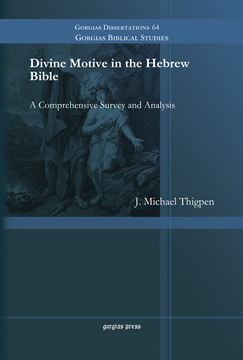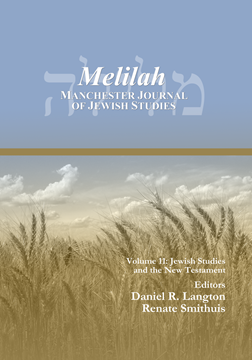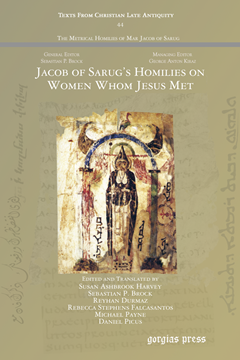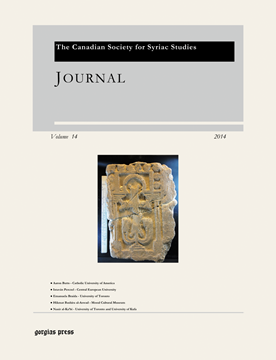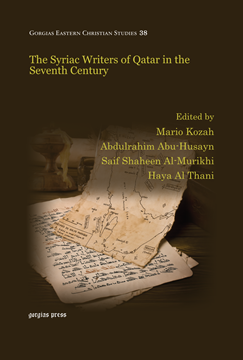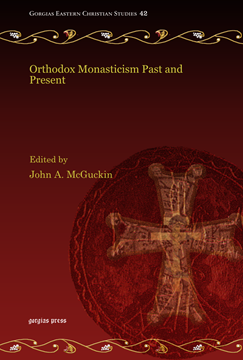The Epistle of the Number by Ibn al-Aḥdab
The transmission of Arabic mathematics to Hebrew circles in medieval Sicily
Series: Perspectives on Society and Culture 2
ISBN: 978-1-4632-0417-4
The first edition of The Epistle of the Number, composed in Syracuse, Sicily, at the end of the 14th century. It is the first known Hebrew treatise to include extensive algebraic theories and procedures, exposing novel mathematical vocabulary, and enhancing our understanding of the linguistic mechanisms which helped create scientific vocabulary in medieval Hebrew.
$203.00 (USD) $121.80 (USD)
Divine Motive in the Hebrew Bible
A Comprehensive Survey and Analysis
Series: Gorgias Biblical Studies 64
ISBN: 978-1-4632-0532-4
This study begins with a comprehensive survey and analysis of divine motive in the Hebrew Bible. Building on the survey it explores divine motive in Jeremiah and Ezekiel, which contain 25% of the divine motive statements in the Hebrew canon.
$147.00 (USD) $88.20 (USD)
The Martyrs of Mount Ber'ain
Edited and Translated by Sebastian P. Brock; Introduction by Paul C. Dilley
ISBN: 978-1-4632-0421-1
The Martyrs of Mount Ber’ain is the poignant tale of three noble Iranian siblings who are martyred under Shapur II. Composed in the seventh century, it demonstrates enduring concerns of Christian self-definition in Iran, especially with respect to the Zoroastrian priesthood.
$43.00 (USD) $25.80 (USD)
Manchester Journal of Jewish Studies (2014)
Jewish Studies and the New Testament
Editors Daniel R. Langton & Renate Smithuis
ISBN: 978-1-4632-0422-8
Melilah is an interdisciplinary electronic journal concerned with Jewish law, history, literature, religion, culture and thought in the ancient, medieval and modern eras.
$50.00 (USD) $30.00 (USD)
Jacob of Sarug's Homilies on Women Whom Jesus Met
Edited and Translated by Susan Ashbrook Harvey, Sebastian P. Brock, Professor Reyhan Durmaz, Rebecca Stephens Falcasantos, Michael L. Payne & Prof. Daniel Picus
Series: Texts from Christian Late Antiquity 44
ISBN: 978-1-4632-0580-5
Five homilies by Jacob of Sarug on women whom Jesus met: the Canaanite Woman, the Samaritan Woman, the Hemorrhaging Woman, the Woman Bent Double, and Jairus' Daughter.
$37.00 (USD) $22.20 (USD)
Syrians and the Others
Cultures of the Christian Orient in the Middle Ages
Edited by Basil Lourié & Nikolai N. Seleznyov
ISBN: 978-1-4632-0424-2
The volume contains the first editions of a number of works of Syrian authors and a publication of Coptic liturgical texts. It also includes a discussion of the letters of Nicetas Stethatos available only in Georgian and other patristic/hagiographical topics.
$216.00 (USD) $129.60 (USD)
Journal of the Canadian Society for Syriac Studies 14
Edited by Amir Harrak
ISBN: 978-1-4632-0469-3
A refereed journal published annually by the Canadian Society for Syriac Studies. Volume 14 includes articles by Aaron Butts, Istvan Perczel, Emanuela Braida, Hikmat Bashir al-Aswad, and Nasir al-Ka'bi.
$75.00 (USD) $45.00 (USD)
Structural Lexicology and the Greek New Testament
Applying Corpus Linguistics for Word Sense Possibility Delimitation Using Collocational Indicators
ISBN: 978-1-4632-0534-8
This study demonstrates a method for using corpus linguistics to disambiguate polysemes in the Greek New Testament. Included are several examples applying the method to exegetically problematic texts.
$182.00 (USD) $109.20 (USD)
The Syriac Writers of Qatar in the Seventh Century
Series: Gorgias Eastern Christian Studies 38
ISBN: 978-1-4632-0524-9
The Syriac writers of Qatar themselves produced some of the best and most sophisticated writing to be found in all Syriac literature of the seventh century, but they have not received the scholarly attention that they deserve in the last half century. This volume seeks to redress this underdevelopment by setting the standard for further research in the sub-field of Beth Qatraye studies.
$157.00 (USD) $94.20 (USD)
Orthodox Monasticism Past and Present
Edited by John A. McGuckin
Series: Gorgias Eastern Christian Studies 42
ISBN: 978-1-4632-0530-0
Studies in Eastern Orthodox monastic life and culture. Part 1 is devoted to New Testament, Patristic, and Byzantine foundations of eastern monastic theory, and Part 2 is comprised of contemporary reflections on Orthodox monastic life.
$230.00 (USD) $138.00 (USD)

